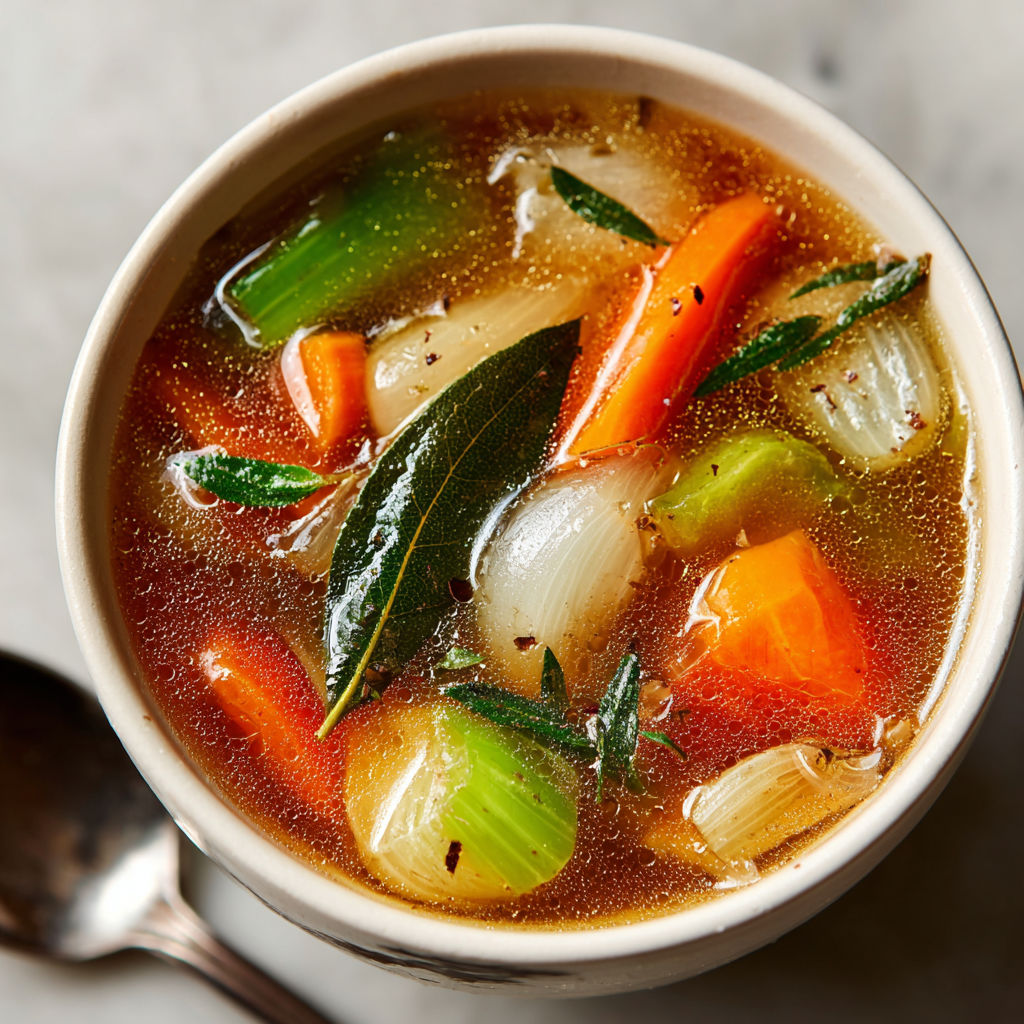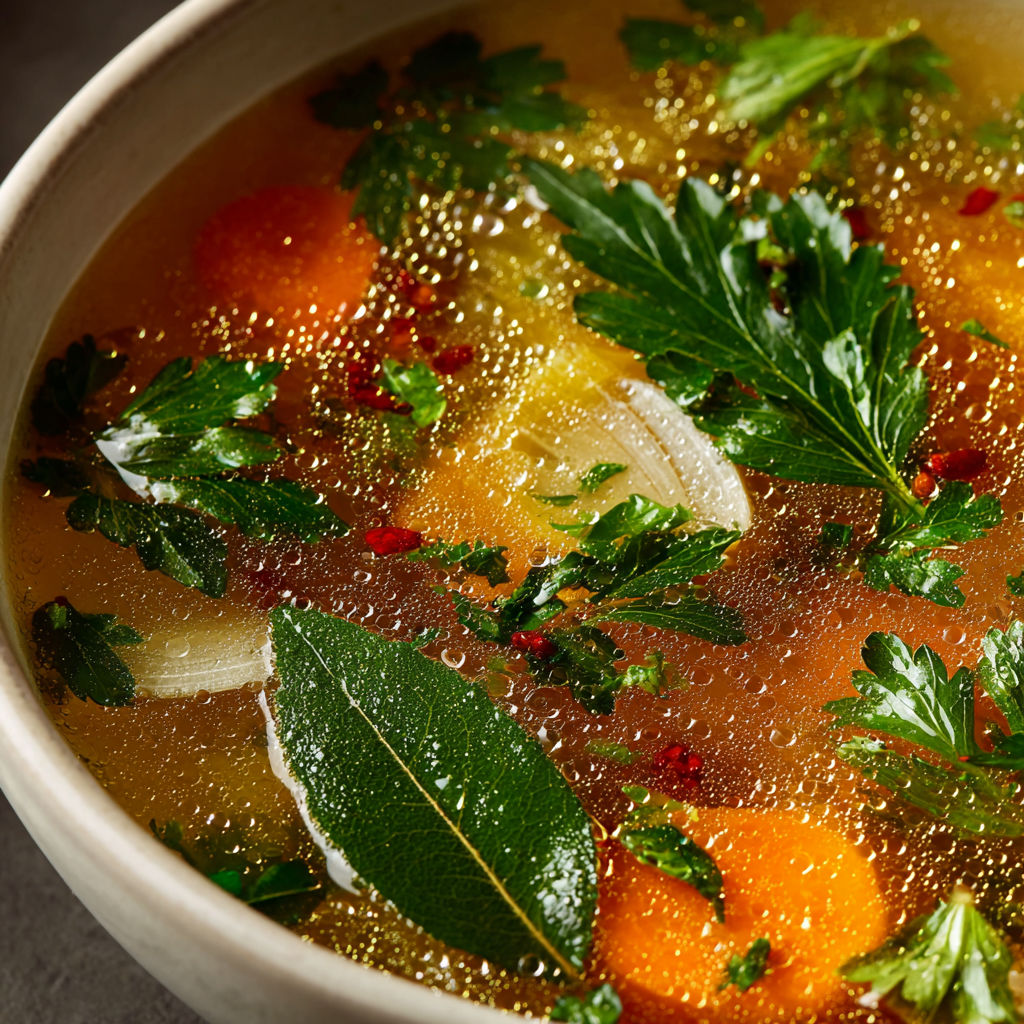 Save
Save This simple homemade veggie broth is my absolute go to way to turn kitchen scraps into pure culinary gold. Whenever I chop veggies for dinner I stash the peels and trimmings in a freezer bag until I have enough for a batch. The broth is full of flavor yet gentle enough for sipping straight or acting as the backbone of cozy soups and sauces.
I started making this broth during a fridge clean out and was floored by how much dimension it adds to risottos and stews This recipe quickly became part of my Sunday routine
Ingredients
- Vegetable scraps such as onion peels carrot tops celery leaves mushroom stems garlic skins: They provide depth and natural sweetness Use clean fresh scraps for best flavor and avoid anything moldy
- Water: The simmering liquid that pulls goodness out of the veggies Use filtered if your tap water is strongly chlorinated
- Bay leaf: This adds mellow complexity and aroma Dried or fresh works just avoid using more than one to keep the broth balanced
- Peppercorns and fresh or dried herbs like thyme or parsley: These bring a subtle earthiness and can be adjusted to suit the dish you plan to use this broth in
- Salt: Just a pinch is all it takes or skip entirely for a sodium free base Add more when you are ready to cook with the broth
Instructions
- Collect the Scraps:
- Gather about four to five cups of clean washed vegetable scraps into a large stockpot Be sure to include only fresh looking bits as spoiled or dirty scraps will affect the flavor Entire carrot tops and onion skins are perfect Mushroom stems add richness
- Add Water and Seasonings:
- Pour eight cups of water over the scraps The liquid should easily cover them Drop in a bay leaf and whatever herbs or peppercorns you like This is the perfect chance to tuck in sprigs of parsley or thyme left over from another recipe
- Simmer Gently:
- Bring the pot up to a full boil over high heat Once it bubbles turn the heat down to a gentle simmer Leave the lid off to concentrate the flavor and let the broth develop slowly This should take an hour minimum but two gives even better taste Skim off any foam or surface impurities occasionally
- Strain and Store:
- Set up a fine mesh sieve or strainer over a large bowl Carefully pour the hot broth through Store the clear broth in glass jars or containers Cool completely before refrigerating If you want a clear broth avoid pressing or squeezing the solids
 Save
Save My favorite ingredient to include is celery leaves They lend a refreshing herbal note that instantly reminds me of Sundays spent in my grandmother's kitchen We both loved the magic of making something out of nothing and that tradition always brings me joy
Storage Tips
Broth stores beautifully in mason jars in the fridge for five days Freeze in ice cube trays for convenient portioning then pop the cubes into a labeled freezer bag If freezing in glass leave plenty of headspace to avoid cracks and thaw gently before using
Ingredient Substitutions
While you can use nearly any veggie scrap I avoid potato peels for starchiness and beet ends if I want to keep the color light Peaks of cauliflower and broccoli can add bitterness so I use them sparingly Herbs from past their prime bunches work wonders
Serving Suggestions
Use this broth anywhere you would reach for boxed stock Try it in risotto to highlight subtle sweetness in grains or as a base for miso noodle soup Sometimes I sip it warm from a mug with a squeeze of lemon for a comforting snack
Cultural Context
Making broth from scraps is rooted in home cooking traditions around the globe From French bouillon to East Asian dashi the concept honors thriftiness and flavor extraction from every last bit of produce
Seasonal Adaptations
Autumn and winter scraps often add heartier notes from squash or leeks Spring offers tender herb trimmings for a fresher broth Summer tomato ends bring a hint of garden sweetness Some helpful notes about this recipe Broth color and flavor will change with the mix of scraps Always cool thoroughly before storing in the fridge or freezer This is a base recipe so adjust seasoning when you use it in a final dish
Success Stories
Friends who doubted homemade broth have been excited by the vibrant color and taste It is a kitchen habit that reduces waste and amazes both new cooks and seasoned pros alike I love showing kids how to turn trimmings into something special
Freezer Meal Conversion
If you double the batch pour some of the broth into ice cube trays and freeze These ready to go cubes can be dropped into cooking grains or reheating leftovers and make meal prep a snap
 Save
Save You will be amazed by this zero waste broth Whether you use it for soups grains or just sip it on its own you will impress yourself and cut down on kitchen waste
Recipe FAQs
- → What vegetables work best for making this broth?
Use onion peels, carrot tops, celery ends, mushroom stems, and garlic skins. Avoid bitter scraps such as cabbage cores or dark greens.
- → How can I store the broth safely?
Keep cooled broth in sealed jars in the refrigerator for up to 5 days, or freeze for up to 3 months.
- → Can I add herbs and seasonings?
Yes, add bay leaves, peppercorns, thyme, parsley, or a dash of salt to enhance the flavor to your liking.
- → Is this broth suitable for all diets?
This broth is vegan, gluten-free, and contains none of the top 8 allergens. Use only safe scraps for your needs.
- → What equipment do I need to prepare this?
You need a large stockpot, a fine mesh strainer or sieve, and suitable storage containers.
- → How long does the cooking process take?
Simmer the broth uncovered for 1–2 hours to extract the most flavor from your vegetable scraps.